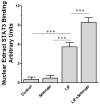Selenate enhances STAT3 transcriptional activity in endothelial cells: differential actions of selenate and selenite on LIF cytokine signaling and cell viability
- PMID: 22366233
- PMCID: PMC3322285
- DOI: 10.1016/j.jinorgbio.2012.01.008
Selenate enhances STAT3 transcriptional activity in endothelial cells: differential actions of selenate and selenite on LIF cytokine signaling and cell viability
Abstract
Sodium selenate may have utility in treating Alzheimer's disease and diabetes; however, its impact on the associated proinflammatory cytokine signaling of endothelial cells has not been investigated. We report that treatment of human microvascular endothelial cells with sodium selenate at a pharmacological dose (100 μM) enhanced tyrosine phosphorylation of nuclear STAT3 on Y705 in response to IL-6-type cytokine, leukemia inhibitory factor (LIF), indicative of enhanced STAT3 activity. Accordingly, STAT3 nuclear binding to DNA was increased, as well as LIF-induced gene expression of chemokine (C-C motif) ligand 2 (CCL2). CCL2 plays a key role in inflammatory processes associated with neuronal degenerative and vascular diseases. The enhancing action of selenate on LIF-induced STAT3 Y705 phosphorylation was replicated by vanadate and a specific inhibitor of protein tyrosine phosphatase, non-receptor type 1 (PTP1B). Moreover, we observed that selenite, the cellular reduction bioproduct of selenate but not selenate itself, inhibited enzymatic activity of human recombinant PTP1B. Our findings support the conclusion that in human microvascular endothelial cells selenate has a vanadate-like effect in inhibiting PTP1B and enhancing proinflammatory STAT3 activation. These findings raise the possibility that beneficial actions of supranutritional levels of selenate for treating Alzheimer's and diabetes may be offset by a proinflammatory action on endothelial cells.
Copyright © 2012 Elsevier Inc. All rights reserved.
Figures







Similar articles
-
Acyloxy nitroso compounds inhibit LIF signaling in endothelial cells and cardiac myocytes: evidence that STAT3 signaling is redox-sensitive.PLoS One. 2012;7(8):e43313. doi: 10.1371/journal.pone.0043313. Epub 2012 Aug 15. PLoS One. 2012. PMID: 22905257 Free PMC article.
-
Calyculin A reveals serine/threonine phosphatase protein phosphatase 1 as a regulatory nodal point in canonical signal transducer and activator of transcription 3 signaling of human microvascular endothelial cells.J Interferon Cytokine Res. 2012 Feb;32(2):87-94. doi: 10.1089/jir.2011.0059. Epub 2011 Dec 5. J Interferon Cytokine Res. 2012. PMID: 22142222 Free PMC article.
-
LIF-JAK1-STAT3 signaling delays contact inhibition of human corneal endothelial cells.Cell Cycle. 2015;14(8):1197-206. doi: 10.1080/15384101.2015.1013667. Cell Cycle. 2015. PMID: 25695744 Free PMC article.
-
Oxidative stress impairs multiple regulatory events to drive persistent cytokine-stimulated STAT3 phosphorylation.Biochim Biophys Acta. 2014 Mar;1843(3):483-94. doi: 10.1016/j.bbamcr.2013.11.015. Biochim Biophys Acta. 2014. PMID: 24286865
-
Active oxygen species generation and cellular damage by additives of parenteral preparations: selenium and sulfhydryl compounds.Nutrition. 1999 Sep;15(9):651-5. doi: 10.1016/s0899-9007(99)00119-7. Nutrition. 1999. PMID: 10467607
Cited by
-
Cerebrospinal fluid of newly diagnosed amyotrophic lateral sclerosis patients exhibits abnormal levels of selenium species including elevated selenite.Neurotoxicology. 2013 Sep;38:25-32. doi: 10.1016/j.neuro.2013.05.016. Epub 2013 May 31. Neurotoxicology. 2013. PMID: 23732511 Free PMC article.
-
Acyloxy nitroso compounds inhibit LIF signaling in endothelial cells and cardiac myocytes: evidence that STAT3 signaling is redox-sensitive.PLoS One. 2012;7(8):e43313. doi: 10.1371/journal.pone.0043313. Epub 2012 Aug 15. PLoS One. 2012. PMID: 22905257 Free PMC article.
-
Responses of an American eel brain endothelial-like cell line to selenium deprivation and to selenite, selenate, and selenomethionine additions in different exposure media.In Vitro Cell Dev Biol Anim. 2017 Dec;53(10):940-953. doi: 10.1007/s11626-017-0196-4. Epub 2017 Sep 22. In Vitro Cell Dev Biol Anim. 2017. PMID: 28940125
References
-
- Hartikainen H. J Trace Elem Med Biol. 2005;18:309–318. - PubMed
-
- Corcoran NM, Martin D, Hutter-Paier B, Windisch M, Nguyen T, Nheu L, Sundstrom LE, Costello AJ, Hovens CM. J Clin Neurosci. 2010;17:1025–1033. - PubMed
-
- Battell ML, Delgatty HL, McNeill JH. Mol Cell Biochem. 1998;179:27–34. - PubMed
-
- Mueller AS, Pallauf J. J Nutr Biochem. 2006;17:548–560. - PubMed
-
- Becker DJ, Reul B, Ozcelikay AT, Buchet JP, Henquin JC, Brichard SM. Diabetologia. 1996;39:3–11. - PubMed
Publication types
MeSH terms
Substances
Grants and funding
LinkOut - more resources
Full Text Sources
Molecular Biology Databases
Miscellaneous

